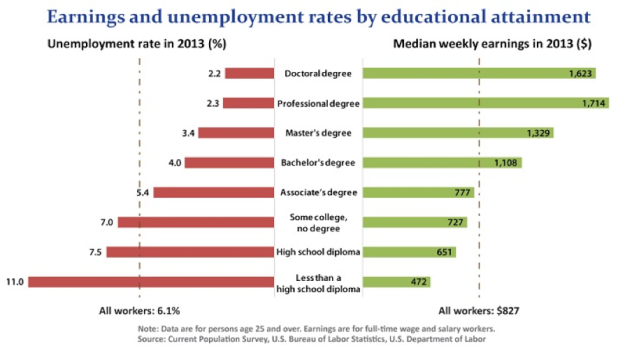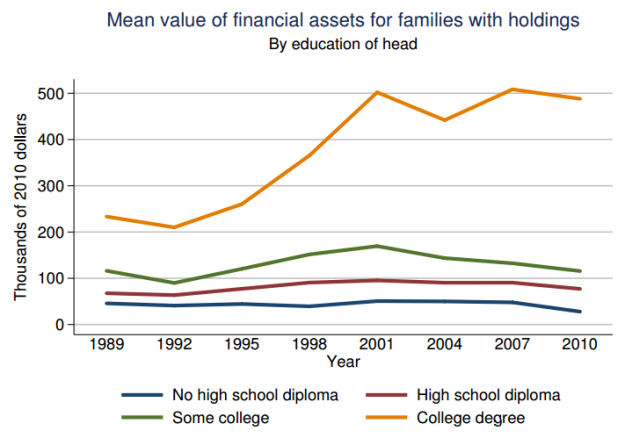Reality is the starting point on the road from the way things are to the way we’d like them to be.
In his New York Times op-ed piece, ‘College’s Priceless Value, Higher Education, Liberal Arts and Shakespeare’, Frank Bruni used his “most transformative educational experience” to argue for degrees in the humanities and against those who see only dollars and cents when they think of higher education.
Bruni’s passion was unmistakeable and hardly misplaced. But with so many pieces just like it in circulation, the public is becoming desensitized to the real issue: the need to open its eyes and the eyes of its children to the reality of the “employment landscape”.
Parents in Canada and the U.S. have yet to acknowledge, let alone step up to, their responsibility to provide the guidance and discipline that goes with preparing their children to be self-sufficient. They point an accusatory finger at an education system that pays lip service to the subject. And at a corporate and political establishment that does much the same. Then they insist on clinging to ideas about university graduation as a general purpose ticket to the good life and a rosy future that are 20 or more years out of date.
Edward Fiske described the hell that was preparation for university entrance in Japan in his 1983 New York Times article entitled ‘Japan’s Schools: Exam Ordeal Rules Each Student’s Destiny’. It was a hell that was not without its casualties. He started his article by saying: “American students, by and large, take examinations to get out of school. Japanese take them to get in. One result is that once Japanese students get to college, they can relax.”
Admission to university was an automatic ticket to the good life. Attending university was anticlimactic. Things have changed. “Cram Schools” continue to figure prominently in Japan. China takes university admission just as seriously.
The Child Trends Data Bank 2011 Home Computer Access and Internet Use report shows how many children have their own personal computers and smartphones before and during high school, usually at no cost to them and with no strings attached. These devices can entertain and enlighten. Why are they not doing both?
There’s no shortage of information about the economy or the labour market. It’s accessible and it’s free. The combined power of the personal computer and the Internet is out of all proportion to its cost. But we’ve conditioned our children to use desktops, laptops, tablets and smartphones as replacements for the family television as North America’s collective, unsupervised electronic babysitter of choice. Children know how awkward their parents are around computer technology so they skate rings around them. They also know that they’re indifferent to how their children are using it. Hackers halfway around the world know more about how children are using those babysitters than the parents of those children do.
China has begun to experience consumers who want everything to be cheap and available now. So says Bloomberg Businessweek’s account of what’s driving Chinese outsourcing in ‘Say Goodbye to Made in China’. If, as Bruni suggests, employers are less than enamoured of graduates with degrees in the humanities, it’s because the times demand it. Shareholders agree. They’re responding as they should to the demand for consumer and corporate technology it takes to run a 21st century country.
Our children aren’t the only ones who aspire to or already have degrees. According to the New York Times (Mr. Bruni’s employer), China’s student population stands at 31 million. In the U.S. there are 21 million. More than 9 million sit for the gaokao (college entry exam) each year; fewer than 3.5 million sit for the SAT and ACT combined. According to the OECD, and as reported by the BBC, there were 129 million university graduates in the OECD/G20 countries in 2010. By 2020, that number will have risen to 204 million. Twenty-nine percent will be in China; 12% in India; 11% in the U.S.; 2% in Canada.
Bruni observed: “It’s impossible to put a dollar value on a nimble, adaptable intellect, which isn’t the fruit of any specific course of study and may be the best tool for an economy and a job market that change unpredictably.” Should we take that to mean that only arts graduates have nimble, adaptable intellects? How would he describe the intellect of the bankers who engineered 2008 and have yet to be charged, let alone tried?
The evidence is mounting that parents have no alternative but to work one-on-one with their children to open their eyes to the labour market if they want to have a future. Gone are the days of teaching them that the best way to deal with preparing for work in the 21st century is to put off confronting it by ignoring it altogether and hoping for the best. We hear the evidence every time a graduate says: “I can’t find work in my chosen field.”
Our children aspire to pictures of the rosy future their parents painted for them based on out-dated experiences. They’ve bought into the notion that universities are places where young people go to “discover themselves”. If that discovery process were working, there would have been no need to write this.
Oxford Dictionaries defines “reality” as:
The world or the state of things as they actually exist, as opposed to an idealistic or notional idea of them
A thing that is actually experienced or seen, especially when this is grim or problematic
Dealing with reality is daunting, but some have dreamed of and succeeded in changing it. The list includes, but is in no way limited to:
Nelson Mandela, Mother Teresa, Grace Murray Hopper, Malala Yousafzai, Oprah Winfrey, Roberta Bondar, Susan B. Anthony, Pearl S. Buck, Helen Keller, Steve Jobs, Bill Gates, Larry Ellison, Dr. Martin Luther King, Jr., Thomas Edison, Guglielmo Marconi, Alexander Graham Bell, Dr. Jonas Salk, Dr. Christian Barnard, Gottlieb Daimler and Karl Benz, Orville and Wilbur Wright, Marie and Pierre Curie, Frederick Banting and Charles Best, Johannes Gutenberg, Albert Einstein, Craig Kielberger, Galileo Galilei, Sir Isaac Newton, Jennie Trout, Coco Chanel, Sandra Day O’Connor, Rosalind Franklin.
The ballet slipper on the right in the Huawei advertisement (top) depicts what many parents see or want to see. The foot on the left says that it takes more than a nimble, adaptable intellect to turn a dream into reality. Career “planning” and career “counselling” imply that the end result will be a foregone conclusion. What’s called for in the 21st century is career prospecting based on hard, verifiable data because there are no foregone conclusions where university degrees are a dime a dozen.
Industries predicated on the humanities aren’t going to roll over and die. There will always be a Broadway, the Oscars, the Emmys, symphony orchestras, the Nobel Prize for Literature, books, poetry, art and philosophy because we will always have a need and an appetite for anything that reflects and talks to us about the human condition. But for the moment, technology, climate change, global warming, the prospect of megadrought, and antibiotic resistant bacteria are beginning to impact on that human condition and they demand our attention.
Without the humanities there would be no: oil paintings, watercolours, sculpture, pottery, blown glass, music, poetry, literature, philosophy, tapestries, television delivered to smartphones and tablets, movies, Oscars, Grammies, Tonys and Clios and pondering of the human condition.
That is a given and it will never change. But for now, the pendulum is swinging in a different direction and we have to give it its due.





